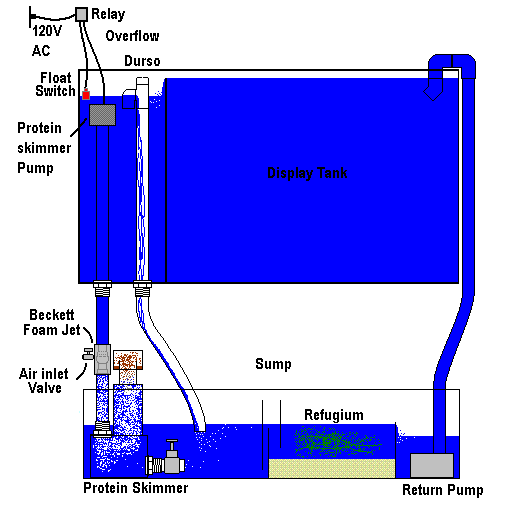Gravity Water Assisted Protein Skimmer Pump DIY
Most setups I have seen handle the inward current of overflow water from the return pump by sending it directly down a drain pipe to the sump.
This creates two significant issues. All that falling water makes a lot of noise and usually creates lots of bubbles. The Durso, Stockman , and the Hoffer Gurgle Buster stand pipes were created to conquer the noise. They do a marvelous job at it too. Even so people with a “standpipe quieter” often find bubble generation in the stand pipe to be a problem and have issues on the other end of the drain line as it enters the sump. Many different mechanisms are created to quiet and reduce the effects of the bubbles and noise in the sump as well. The problem is worsened by the quantity of water cycling through the sump.
Gravity assisted free energy pump system
So in contemplating my design, I realized that the reason for the noise and the excess of bubbles is one single thing: the kinetic energy of the water. In a conventional system your tank stands almost 5 feet tall (mine 6) and the sump is at floor level. That’s a long drop. For me that is 1.5 PSI of pressure that get’s thrown away. It’s pretty common as well to hear of people in the reef forums continually upgrading the pump running their skimmer because they are looking for greater bubble generation. What if you could get that extra power for free without paying for it in a larger pump and every month in the electric bill? What if a side benefit as well was reducing the effects of noise and bubbles in the overflow drain system? The answer was to harness the potential energy of the water in the overlow.
My protein skimmer is powered from a MAG 5 placed in the overflow compartment on the inlet of the drain tube that connects to the skimmer. This provides a way to harness the potential energy of the overflow water which is 5.5′ higher than the sump base. The 40 inch drop from the pump to the beckett foam jet nozzle provides approx. 1.5 PSI of additional pressure. The MAG 5 generates around 4.5 PSI so I get around 6 PSI in theory.
Water Flow Rates
One constraint on the system for this to work is the flow of water coming into the overflow must be greater than the flow the MAG 5 generates. My return pump is a MAG12 and is pushing around 820GPH in this configuration. The skimmer pump pushes a fixed amount throught the spray injector. I route the rest of the flow coming into the overflow box down two durso standpipes. This keeps the skimmer pump from running dry and keeps constant pressure on the injector. Since the MAG 12 is pushing significantly more water than the MAG 5 does, the water level in the overflow stays at the durso inlet height. This keeps the MAG 5 completely enveloped with water so it doesn’t run dry and keeps it under constant pressure. I have also added a float switch to this compartment to automatically shut off the MAG5 when the water level drops to a level close to the pump intake.
This configuration lends itself well to Venturis, Spray Injection, and Becket foam jets. I recently switched from using a spray injector for my air injection to a beckett foam jet and have been blown away by the results. It’s over 2x more visible bubble generation and smaller bubbles too. I haven’t compared using a air flow meter.
On a side note, my original plan was to not have to have a skimmer pump at all. I did infact design my first skimmer body and spray injector around this idea. Did it work? Yes. Did it work well? No. 1.5 PSI wasn’t enought pressure to generate enough bubbles to efficiently skim a 130 gallon system. I ran it in this configuration for the first month.
During this time the live rock I had ordered cured, the tank cycled and I had my first inhabitants (janitor crew) in the system. During the curing on the worst day it actually pulled 1.5 quarts of dark brown skimmate (yes in one day). That might be typical of the curing process. I have only done it once. Most of the time it just pulled a little skimmate at a time maybe a cup a week. It simply doesn’t compare to the way I have it operating now with the MAG 5. But that is not to say that it couldn’t work without a pump on a 30 gallon or similar system. Remember its around the same drop from a 30 gallon tank to the sump as it is from a 200 gallon tank to the sump.

